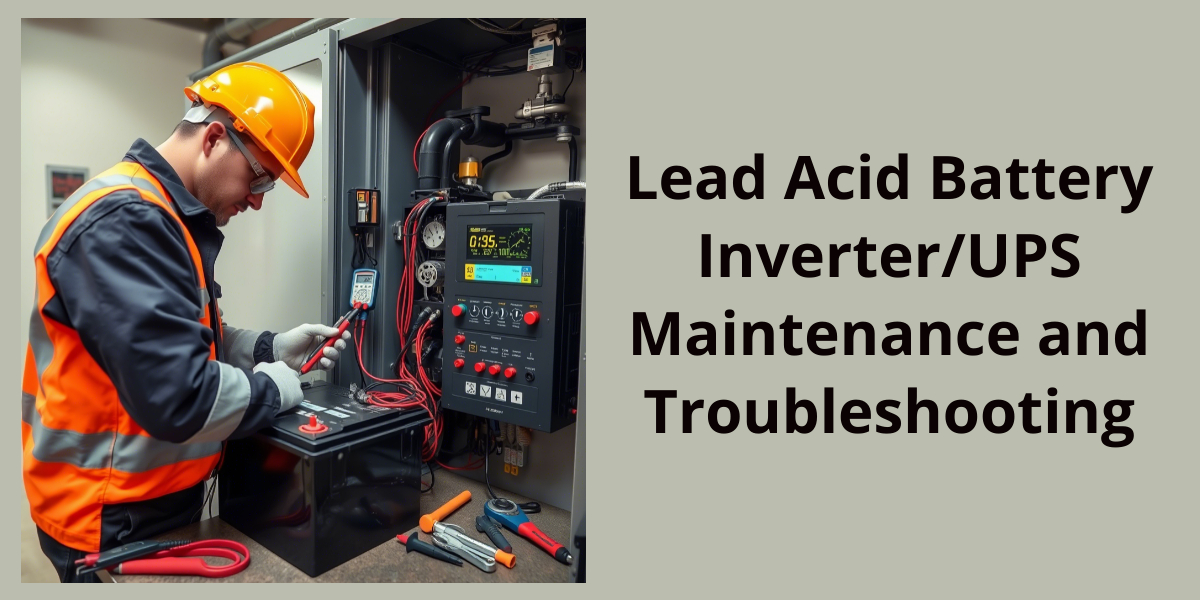|
Getting your Trinity Audio player ready...
|
Lead-acid batteries are a common energy storage solution for inverters and uninterruptible power supplies (UPS). Regular maintenance and troubleshooting are crucial to ensure their optimal performance, longevity, and safety. This article will provide a comprehensive guide on maintaining and troubleshooting lead-acid batteries in inverter/UPS systems.
Maintenance
-
Regular Inspections:
- Visual Inspection: Regularly inspect batteries for any signs of physical damage, such as cracks, bulges, or corrosion. Check for electrolyte leakage and ensure that the battery terminals are clean and free from corrosion.
- Electrolyte Level Check: For flooded lead-acid batteries, regularly check the electrolyte level and top up with distilled water as needed. Ensure the electrolyte level is within the recommended range.
-
Charging:
- Regular Charging: Regularly charge the batteries according to the manufacturer’s recommendations. Avoid overcharging or undercharging, as both can significantly shorten battery life. Use a suitable battery charger with appropriate charging profiles.
- Equalization Charging: Periodically perform equalization charging to ensure all cells in the battery bank are fully charged and balanced. This helps to prevent undercharging of individual cells.
-
Temperature Monitoring:
- Temperature Control: Maintain the battery temperature within the recommended range. High temperatures can accelerate battery degradation, while low temperatures can reduce battery capacity. Consider using temperature-controlled battery rooms or enclosures.
-
Ventilation:
- Proper Ventilation: Ensure adequate ventilation around the batteries to prevent the buildup of hydrogen gas, which is a byproduct of battery charging. Poor ventilation can create a fire hazard.
-
Cleaning:
- Keep Clean: Regularly clean the battery terminals and surrounding areas to prevent corrosion buildup. Use a baking soda solution or a commercial battery terminal cleaner.
Troubleshooting
-
Reduced Battery Life:
- Overcharging/Undercharging: Check the charging system and ensure that the battery is being charged and discharged within the recommended limits.
- High Temperatures: Monitor battery temperatures and take corrective action if necessary.
- Sulfation: Sulfation can occur due to prolonged periods of undercharging or deep discharge. Consider using a desulfation charger to restore battery capacity.
-
Low Battery Voltage:
- Low State of Charge: Check the battery charge level and recharge the battery if necessary.
- Internal Short Circuit: A short circuit within a cell can cause a significant drop in voltage. Conduct a cell-by-cell voltage test to identify the faulty cell.
-
Excessive Gassing:
- Overcharging: Reduce the charging current or voltage to prevent excessive gassing.
- High Temperatures: Reduce battery temperatures to minimize gassing.
-
Electrolyte Leakage:
- Cracked or Damaged Battery Case: Replace the damaged battery.
- Loose Connections: Tighten loose connections to prevent electrolyte leakage.
-
Battery Swelling:
- Overcharging: Reduce the charging current or voltage.
- Internal Short Circuit: Replace the faulty battery.
Safety Precautions
- Wear Protective Gear: Always wear eye protection and gloves when working with lead-acid batteries.
- Avoid Sparks: Avoid sparks or open flames near batteries, as hydrogen gas can be explosive.
- Proper Ventilation: Ensure adequate ventilation to prevent the buildup of hydrogen gas.
- Grounding: Properly ground the battery system to prevent electrical shocks.
Conclusion
By following these maintenance and troubleshooting guidelines, you can significantly extend the lifespan of your lead-acid batteries and ensure the reliable operation of your inverter/UPS system. Regular inspections, proper charging, and addressing issues promptly are key to maintaining a healthy battery bank. Remember to always prioritize safety when working with lead-acid battery.



“Great content, learned a lot from this post!”
Mitolyn Good post! We will be linking to this partspacelarly great post on our site. Keep up the great writing
I just wanted to drop by and say how much I appreciate your blog. Your writing style is both engaging and informative, making it a pleasure to read. Looking forward to your future posts!
I regard something genuinely interesting about your weblog so I saved to my bookmarks.
Greetings from Florida! I’m bored at work so I decided to check out your blog on my iphone during lunch break. I enjoy the info you present here and can’t wait to take a look when I get home. I’m surprised at how fast your blog loaded on my phone .. I’m not even using WIFI, just 3G .. Anyhow, very good blog!